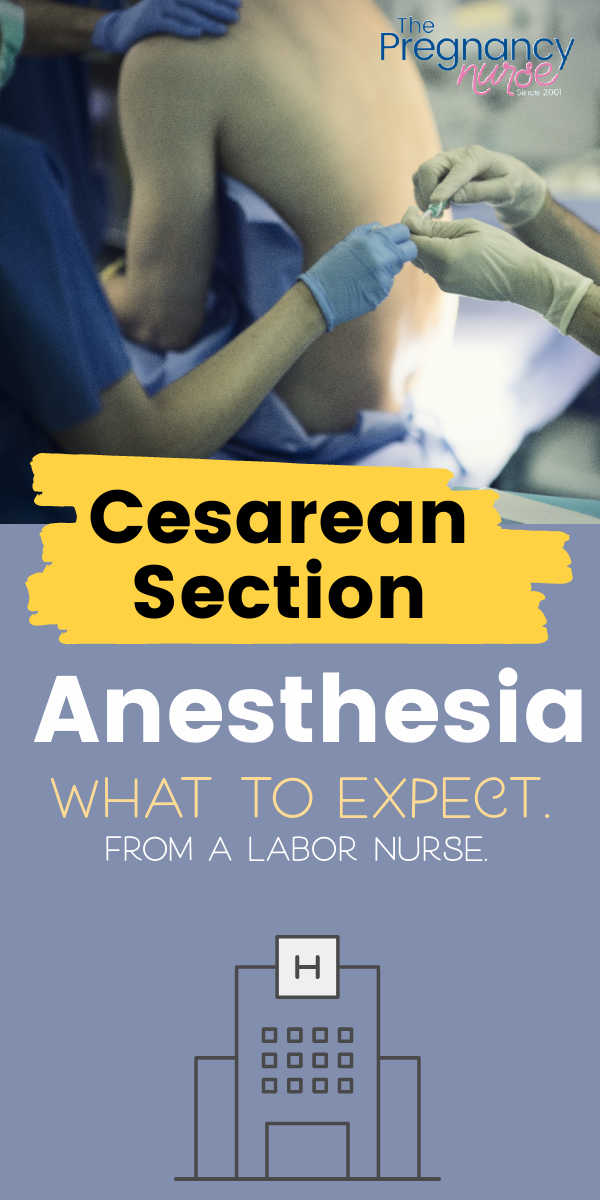Your choice of cesarean section anesthsia is not too broad. There are mainly two humane choices for a cesarean section. Today I’ll discuss both of them, along with some of the risks and the benefits of each.
As always, if you are planning on a cesarean section, or your doctor has mentioned it could be likely. I would recommend talking to them about what your anesthesia choices are. They know you and your specific circumstances.
And, because I believe you should always check sources. Hi, my name is Hilary Erickson — I’m The Pregnancy Nurse. I’ve been an RN since 1998, and I have 20 years of labor and delivery experience. I have been in thousands of cesarean sections at multiple locations and with lots of different kinds of moms, so I think I’ll have a good viewpoint for you on this topic.
What is Anesthesia?
Anesthesia is basically a way for you to not feel things when you’re having surgery. There area few types:
General Anesthesia
This is when you are entirely put to sleep during a procedure. General meaning your entire body is asleep using general anesthetic.
Regional Anesthesia
This is when just an area of your body is numbed for a procedure. Most often this is done through an epidural or a nerve block. In a cesarean section it is done with a spinal block (in labor it would be epidural anesthesia — and we’ll chat about the differences).
Local Anesthesia
This is when they just numb the specific area that could cause pain. Most people know this from the dental office, or if they have stitches and they numb that area with an injection.
As an FYI I do have an entire chapter on cesarean sections in my best-selling Online Prenatal Class for Couples. So many families are super grateful for that section that walks you through the entire procedure, and what to expect.
Have you checked a birth class off your to do list✅? I have a few I recommend:
❤️ Best class for couples {per BabyList}
👩💻 Best class available on demand
⚡ Best class JUST for pain management
👶 Best Postpartum-Only Prep
❤️🧡💛💚💙💜 My favorite class is here.
Now is the time to get started!
I also have a portion about what is different with a cesarean birth after delivery. I love what Emily had to say:
These classes were everything I wanted and more!!! The lessons were short and sweet without skimming on information. It was great for my husband too, because it wasn’t all about Me and the Baby, and he finally felt involved.
Emily M — read more reviews here.
Who provides Anesthesia?
Anesthesia must be provided by either an Anesthesiologist or a nurse anesthetists (this is basically a nurse practitioner who went to specific schooling providing anesthesia — states vary in how they allow them to practice).
Cesarean Section Anesthesia
With a caesarian section they can use all three methods. It will be up to your provider to give you the risks and the benefits of all the methods, these are just the most common (but they may vary depending on you and your circumstances). And these methods area also used in other surgical procedures in the operating room (knee replacements, etc).
General Anesthesia for a Cesarean Section
You will be entirely out for the procedure. You will not remember anything from the beginning of it til’ we wake you up after it is completed.
Pro Tip: check out my post with 15 awesome c-section facts for your educational perusal too!
Risks of General Anesthesia in a Cesarean Section
The saddest thing, although not really a “risk” per se — is that you won’t remember your baby’s delivery. Because you will be “out” the whole time you will meet your baby for the first time in the post-anesthesia-care-unit where you are tired, groggy and likely hurting.
The other risk may vary by hospital, but because general anesthesia is a much more intensive procedure that takes more attention for the anesthesiologist (and frankly, it is hard to look at) — your 2nd person is not allowed into the OR. However, if this is the case your baby can be taken to them upon delivery so they can do skin to skin (and make sure they take LOTS of pictures for you). Some hospitals may allow them in the room, but any that I’ve worked at, or heard of — did not.
But, along the lines of the baby — one of the largest problems with general anesthesia for cesarean section is that the medications given to you do pass to the baby (which could make them sleepy, less likely to cry and expel the amniotic fluid from their lungs). That means once they put you under the physicians are quick to get the baby out, so they get as little medication as possible.
I have always HEARD this to be true (and seen it for myself) but I did read this article that said there was not significant difference for the baby. So, that may not actually be true. I think the risks are mitigated because they physicians work to get the baby out very quickly when general anesthesia is used.
There are always risks involved in all the medications that they use for general anesthesia. It can take days/weeks for those medications to leave your system I have been told by moms.
There is also the risk of intubation where they could chip a tooth (unlikely) and you will likely have a sore throat from it.
The other risk is that is just isn’t as good of pain relief. You don’t have any residual pain mangement left as you’ll see in “regional anesthesia”. That is mostly why we don’t like this method as much.
Benefits of General Anesthesia in a Cesarean Section
A lot of women ask for this method because they do not want to even think about the surgery happening, the idea of it gives them anxiety. So, one benefit is that you don’t have any anxiety of the procedure.
The other benefit is that it can be done quickly. Use of general anesthesia is mainly what we use when the surgery must happen immediately due to an emergency situations (you’ll find people often say their baby was delivered as an emergency, but unless they were put under general anesthesia it likely wasn’t a “true emergency”).
Conditions like this might be:
- Baby’s heart rate has some serious issues and isn’t recovering
- There is an abruption of the placenta and both mom and baby are bleeding a lot
- The birth of your baby will save your’s or your baby’s life.
It can also happen due to other medical conditions (especially big back issues in the area they normally use).
As you can imagine, anesthesiologists are trained to get people under anesthesia very quickly — which is important when seconds matter to you or your baby’s life.
Regional Anesthesia for a Cesarean Section
This is the most often used method for anesthesia for pregnant women during a cesarean deliveries. It can be given as spinal anesthesia, or — if you already have an epidural infusing (and working) they can add extra epidural anesthetics to that to numb you up more than they would for a vaginal delivery.
Risks of Regional Anesthesia in a Cesarean Section
There is always the risk of placement going wrong (most often that results in a spinal headache), or infection at the site of the placement (as they will break the skin).
There could be the risk that it won’t work or they are unable to place it (this can happen for a variety of reasons) — but if it doesn’t work they can always put you under general anesthesia if they are unable to try again.
It is also possible that you will feel “some” of the pain during the surgery. If this happens, your anesthesiologist is on hand to provider more pain relief and other methods to help you tolerate the surgery
There is also a chance that your blood pressure could drop. But they have medications, and fluids on hand to help with this in the operating room.
Benefits of Regional Anesthesia in a Cesarean Section
The two main benefits are:
- You are awake for the delivery of your child. While the idea of being awake during major surgery does sound daunting, most women don’t find it too horrible as baby is usually out fairly quickly and their partner can be with them as they see the baby for the first time and often get to hold them.
- You have greater pain relief following delivery. It takes almost 24 hours for that to entirely wear off (and the pain management centers around your surgical area so that’s extra handy). That means you have to take less pain pills and often have a better recovery overall.

Also, the regional anesthesia is not passed through the placenta to baby. Although baby does have more risks during a cesarean delivery in general, they won’t have the added risk of general anesthesia in their system as well.
If you’re wondering how epidural anesthetics are placed (this is also the same procedure for a spinal, up until they introduce the epidural catheter) I have a video where I show me putting one in on a doll:
Local Anesthesia for Cesarean Section
This would be where they just numb the skin.
I have seen this and I wouldn’t recommend it. I think it would only happen if anesthesia wasn’t available and the physician believed baby had too much risk staying inside at that time. I won’t go into the risks and the benefits of this as it would only be for extreme circumstances.
What Anesthesia is most often used for a Cesarean Section?
If you come in for a scheduled cesarean section you will likely be encouraged to have a spinal black placed. Due to its lower risks to you and the baby, along with being able to see the delivery and residual pain mangement — it is the best way.
If you already have an epidural infusing they would just dose that up.
That all being said — what you are interested in is what will be used for YOUR Cesarean and you won’t actually know that until it happens. But, hopefully this gave you some idea of what to expect for your upcoming surgery.
I hope you’ll join me in my online prenatal class to get prepared for your whole delivery. Be sure to check out the reviews if you have questions!






 Diastasis Recti Pain During Pregnancy
Diastasis Recti Pain During Pregnancy

[…] vaginal deliveries, and spinal anesthesia is used for cesarean deliveries (I have a whole post on cesarean anesthesia). BUT the epidural can be used during an emergent cesarean to help provide adequate pain relief as […]